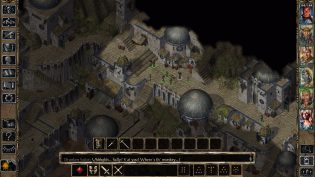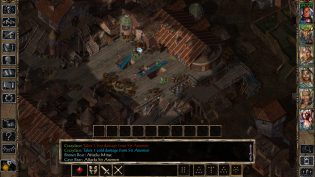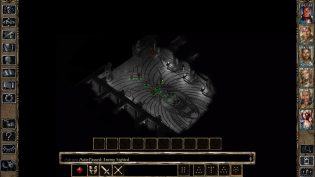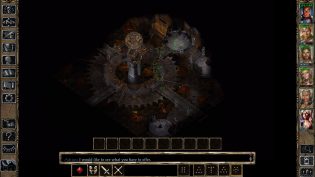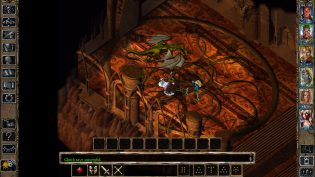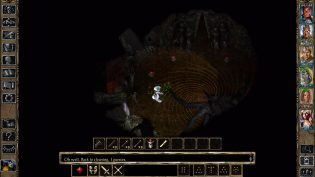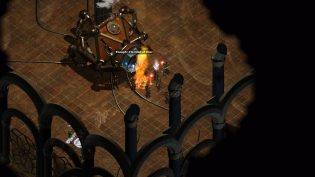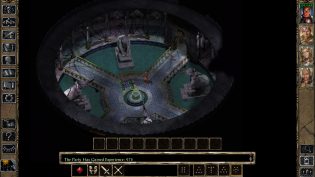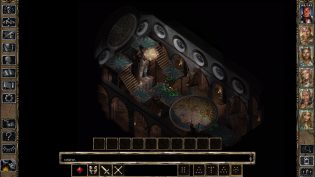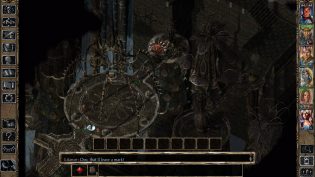O tempora is a series of retrospective posts where I play games from ages before to see if they stood the test of time.
Often times when people reminisce about Baldur’s Gate they seem to remember the second game, Shadows of Amn, with more reverence. Not surprising, really, it was more beautiful, better balanced, far more “epic”, told a far more involved and personal story and even introduced the concept of “Romances” that BioWare would become known for in their RPG titles. It is still considered to be one of the best cRPGs, especially among the story-focused variety and rightfully so. Though, revisiting it now, in the Enhanced Edition (that includes the expansion/final part of the Trilogy Throne of Bhaal and some new content) did reveal some elements that I blissfully forgot until now.
Unlike the original title that kept the mystery of the main character’s birthright a secret throughout most of the game and kept it as a secondary storyline in comparison to the economical and political events, Baldur’s Gate II is all about personal stakes right from the start. Your character and some of the companions from the first game were kidnapped, experimented upon and some of you have not survived the process. There’s a face tied to these acts and that face is asking to be kicked in the teeth. That’s your motivation for the game and while the stakes do often times imply things far bigger than revenge, it’s often up to the players if they want to care about it or not.
The whole game structure and feel is changed to accommodate that – you don’t wander much, most of the locations are added to your map by NPCs when they want you to go to a specific place and you don’t unlock things by just exploring usually. Map sizes are wildly different and always adapt to the needs of the location/quest, often leaning towards more dramatic, more tightly put together and directed experiences. Quests tend to have more story to them, more twists and talks and all the companions that you can get, of which there are considerably less than in the first game, have a more notable place in the adventure. Even discounting the “Romance” options, you talk to people more. Though, still, far less than whatever new content added in the Enhanced Edition tries to add – new companions in EE still feel completely out of place with just how talkative, often to a fault, they are.
What was most surprising for me to remember, however, is that despite the game being more linear and having less quests and locations in terms of pure numbers, the game overall is longer. You visit lots of very different places, some of which can never be revisited, all of which have new sets of mini-stories, characters and themes. Even more interestingly, some of them can be skipped almost entirely based on player choice despite being along the main story path.
The strongest point of Baldur’s Gate II remains in how really memorable the events are and how well they are written. Where original title was just well done and serviceable, Shadows of Amn tries a lot of really cool ideas in mixing more “cinematic” concepts into the interactive world of the cRPG. Questlines still can be awkwardly rigid, but it feels like your choices are more meaningful and your connections to other characters are far stronger then before. “Romance” was still an infant idea in lots of ways, mostly broken by how story+time-based dialogues work in the game (aka how they don’t work), and it was in many ways unfinished. Yet, unlike any other attempt at the concept since this title BioWare did, this is the only time where the relationship with a character you can establish can go through some stupidly serious events unique just for that character, including literal life and death choices, countless times where emotions can mean losing the character forever and, probably most famously, having a child with a character. That gets born during the course of the game. And becomes an actual “item” you both carry in your adventures.
Shame that the character in question is insufferable, though… And that’s another side of the approach – due to how involved and how important the personalities and the stories are in the game, the mechanics and the story often get into extremely annoying conflicts. Apart from the annoyances with dialogues just not triggering because of reasons (something lots of mods fixed, yet EE unfortunately didn’t) you’re very likely to encounter situations where you really want to keep a character for their story, yet they’re completely useless for your party or just don’t fit due to the alignment, or the opposite – run around with someone really good mechanically, but hating them every time they open their mouth for a character bark. And due to the more limited selection of companions in comparison to the original title, this is far harder to get around. Here EE is, again, really failing and bringing mostly annoying characters who give very few reasons to ever hang out with them, apparently Beamdog hasn’t figured that part out until the Siege of Dragonspear.
But playing BGII is extremely fun, if sometimes you do catch yourself thinking that the game is a tiny bit too long. Throne of Bhaal is, luckily, not particularly long, though. It was a fine ending to the Gorion’s Ward story, even if it felt a bit rushed and mechanically too reliant on linear runs through dungeons with very high level enemies. It hasn’t aged as well as I’ve remembered and if I’m being entirely honest, as a piece of content Dragonspear is a more enjoyable title, for all its faults, but I still enjoyed playing it. I just wish EE would fix/change more of the minor problems with it which have been addressed over the years by fans of the original yet were left as in the original release here.
Baldur’s Gate Trilogy is still an enjoyable time. While it’s not my favorite story-driven RPG and not even the favorite Infinity Engine game/series of games (we’ll get to that later, chief), it’s not good just for its legacy or influence on the genre. It still holds up today as an enjoyable game. Enhanced Edition, despite not being as enhanced as it should’ve been (and having an option to outright remove the companion additions that detract more than add), is a great way to revisit the games. I’d still suggest playing through games as they were released originally and looking at the Siege of Dragonspear only after you’ve experienced the original trilogy. But suggest playing through all these games I still will.




